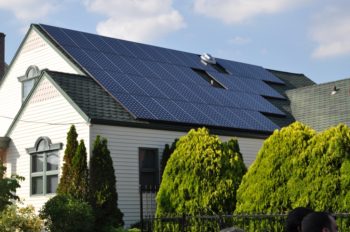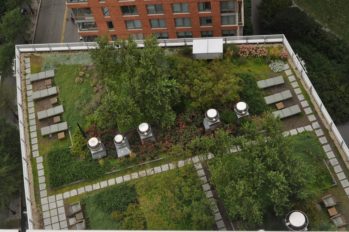
Solar Photovoltaic System Image Credit: DOB
Green Roofs and Solar Roof Systems should help buildings throughout the city maintain appropriate temperatures while cutting down on energy costs and emissions. On November 15, 2019, the Department of Buildings announced the effectiveness of Local Laws 92 and 94 of 2019. Local Law 92 (Intro 0276) was originally introduced by Council Member Donovan J. Richards on January 31, 2018 and Local Law 94 (Intro 1032) was introduced by Council Member Rafael L. Espinal, Jr. on July 7, 2018. The bills were approved by City Council on April 18, 2019, adopted by the administration on May 19, 2019 and returned unsigned by the Mayor the next day. These bills were introduced to provide buildings with insulation and combat heat island effect. Heat island effect has been tied to increased energy demand, air conditioning costs, air pollution, greenhouse gas emissions, heat-related illness and deaths.
Law Summary
These laws amend the New York City Building Code to require all new buildings and buildings undergoing major roof renovations to install solar photovoltaic systems, a green roof system or a combination of the two. The sustainable roofing must cover the roof in its entirety. Green roofs and the solar photovoltaic system are described below.
Green Roofs
Green roofs have vegetation that absorbs rainwater, provides insulation, and combats the heat island effect. Urban environments generally have higher temperatures than surrounding areas. Since green roofs add substantial weight to a building’s structure, one must always hire a Professional Engineer or Registered Architect to perform structural analysis to determine if the existing roof can support the added load without a modification.
Solar Photovoltaic Systems
The major components of a solar photovoltaic system include individual solar panels made of photovoltaic cells. Then inverters convert the variable direct current output from the photovoltaic solar panels into a utility frequency, alternating current, which can be fed into the electrical grid. The inverter is a critical balancing component in a photovoltaic system. The utility meter tracks electricity from a solar energy system sent to the utility for credits and electricity sent from the utility when the solar energy does not provide enough to the building. The system also includes electric safety gear such as fuses, breakers, disconnects and monitoring equipment and batteries can be added for additional energy storage.

Green Roof Image Credit: DOB
Filing Requirements
All new Buildings applications filed, on or after November 15, 2019, for new construction projects and roof alteration projects (including vertical and horizontal enlargement or roof deck replacement), must include a form certifying their compliance with Local Laws 92 and 94. All Buildings filings that have not been approved by Buildings by 3PM on November 14, 2019, will be required to submit the new Solar and Green Roof Systems form prior to Buildings approval.
Statements
According to a November 15 press release from the Mayor’s office, building emissions currently account for 70 percent of greenhouse gas emissions in New York City. These new laws represent a significant step forward in realizing Mayor de Blasio’s goal of New York City becoming carbon neutral by 2050, and are a major component of the City’s efforts to mitigate climate change. The laws also support efforts to enhance stormwater management, which will reduce urban flooding and improve the health of New York Harbor and its tributaries.
Buildings Commissioner Melanie E. La Rocca stated “In New York City, we are not shirking from the challenge of climate change, these new laws are a sea change in how we approach new buildings, and help make our city a national leader in reducing emissions. With the biggest energy team in the country, we are ready and able to be a resource and provide technical assistance to the real estate industry as we work together to tackle this challenge head on.”
Mark Chambers, Director of the Mayor’s office of Sustainability said “These laws use the power of design and construction to dramatically increase renewable energy and stormwater management throughout the city. The leadership of the Department of Buildings in making this shift accessible to New Yorkers continues to be exemplary in bringing this work to life.”
Council Member Donovan Richards stated “The implementation of Local Laws 92 and 94 of 2019 will ensure that New York City is at the forefront of the transition to a cleaner and greener future for all New Yorkers. Utilizing valuable rooftop space to continue reducing out carbon emissions will also help reduce energy costs, improve stormwater management and make our city more livable for generations to come. We look forward to seeing more and more innovative ways to enhance green infrastructure as buildings begin to pop up in compliance with these laws.”
It is important to note that there’s a myriad of exceptions to the laws and multiple pathways to accomplish these goals. For a more detailed explanation of the requirements of Local Laws 92 and 94 of 2019, see Buildings Bulletin 2019-010.
By: Jason Rogovich (Jason Rogovich is the CityLaw Fellow and New York Law School Graduate, Class of 2019)
















Fascinating. Definitely bookmarking this page. Really valuable info, thanks for posting.